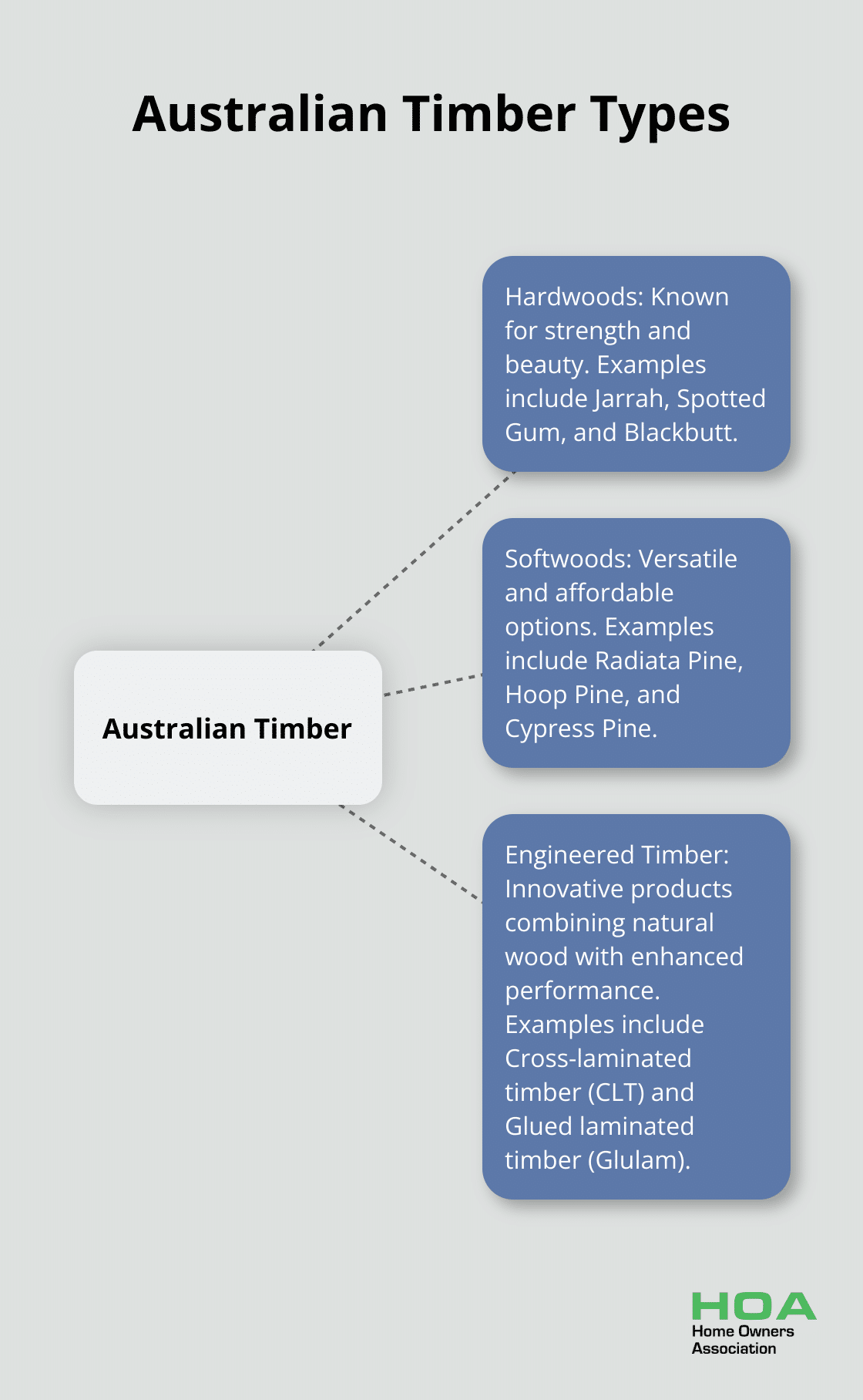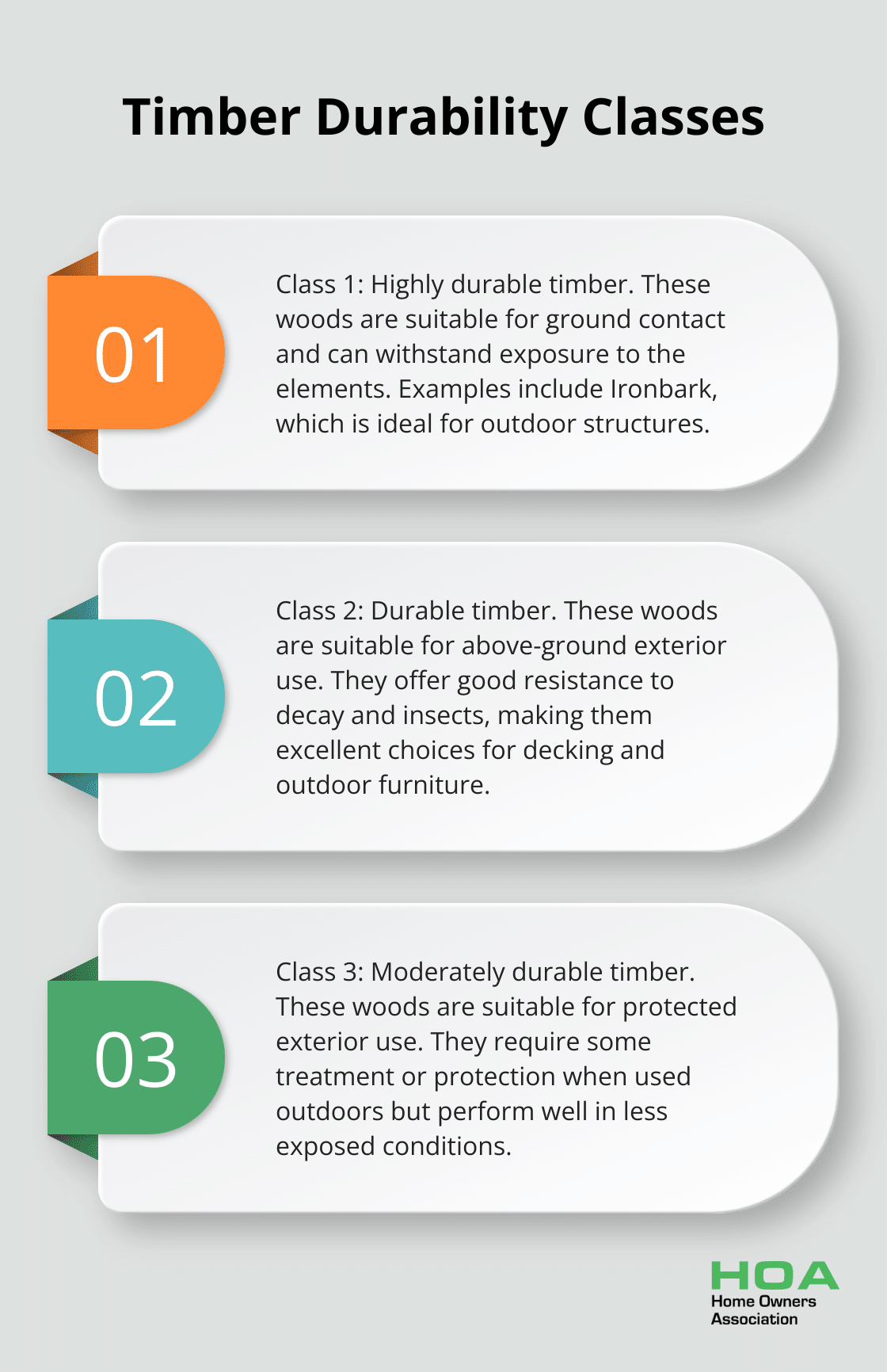
Australian timber supplies are renowned for their quality and versatility in home projects. From sturdy hardwoods to versatile softwoods, our country offers a wide range of options for homeowners and builders alike.
At Home Owners Association, we understand the importance of selecting the right timber for your specific needs. This guide will help you navigate the world of Australian timber, from understanding different types to sourcing quality materials for your next project.
Australian Timber Types for Your Home Project
Hardwoods: Strength and Beauty Combined
Australian hardwoods offer durability and aesthetic appeal for various home projects. Jarrah, native to Western Australia, showcases a rich red-brown colour and is very durable in terms of decay resistance. It is also quite resistant to insect attack, making it an excellent choice for outdoor structures and high-end furniture. Spotted Gum, found along the east coast, features a striking grain pattern and high strength, which suits it perfectly for flooring and decking applications. Blackbutt, another east coast species, stands out with its pale cream to light brown colour and natural fire resistance (a top pick for bushfire-prone areas).
Softwoods: Versatility and Affordability
Softwoods provide budget-friendly options without compromising quality. Radiata Pine, widely plantation-grown in Australia, works easily and accepts treatments well, making it versatile for both indoor and outdoor use. Hoop Pine, native to Queensland, boasts a straight grain and often finds its way into plywood production and interior joinery. Cypress Pine distinguishes itself with natural termite resistance and a pleasant aroma, excelling in outdoor structures and indoor feature walls.

Engineered Timber: Innovation Meets Tradition
Engineered timber products combine natural wood’s beauty with enhanced stability and performance. Cross-laminated timber (CLT) has gained popularity in Australia for its strength and environmental benefits, allowing faster construction times in large-scale projects. Glued laminated timber (Glulam) offers exceptional strength-to-weight ratios, making it ideal for long-span beams and architectural features.
Selecting the Right Timber for Your Project
When choosing timber for your project, consider factors such as durability, appearance, and intended use. For outdoor projects exposed to the elements, naturally durable hardwoods or treated softwoods work best. Indoor applications may prioritise appearance and workability. Engineered options can solve specific structural or design challenges.
Sustainable Timber Choices
A growing trend towards sustainable timber choices has emerged among Australian homeowners. Many opt for locally sourced, certified timber to reduce environmental impact and support Australian industries. This shift aligns with the increasing awareness of eco-friendly building practices and responsible forestry management.
The wide array of Australian timber options ensures that you’ll find the perfect match for your project, whether you prioritise strength, beauty, or sustainability. As you move forward in your timber selection process, understanding how to source quality materials becomes the next crucial step in ensuring the success of your home project.
Where to Find Quality Australian Timber
The Local Advantage
Choosing local timber suppliers offers numerous benefits for your project. Local suppliers provide fresher, better-maintained stock due to shorter supply chains. This results in wood that has a lower likelihood of warping or developing other issues before it reaches you.
Local suppliers also possess a deeper understanding of regional timber species and their specific characteristics. This expertise proves invaluable when you select the right wood for your particular project. For example, a local supplier in Queensland might offer expert advice on using Hoop Pine for interior joinery, based on years of experience with the species in similar applications.
Identifying Reputable Timber Merchants
Finding a trustworthy timber merchant ensures you receive quality materials. Look for suppliers with a solid reputation in the industry. Check online reviews and ask for recommendations from local builders or architects. These professionals often have long-standing relationships with reliable suppliers and can guide you in the right direction.
A reputable timber merchant should provide detailed information about their products (including the timber’s origin, grade, and any treatments applied). They should also answer your questions and offer advice on selecting the right timber for your specific needs.
Visit the supplier’s yard in person to inspect the timber firsthand and assess the overall quality of their stock. A well-organised yard with properly stored timber often indicates a merchant who takes pride in their products.
Certification and Sustainable Sourcing
The importance of certification and sustainable sourcing cannot be overstated in today’s environmentally conscious world. Look for timber certified by recognised organisations such as the Forest Stewardship Council (FSC) or the Programme for the Endorsement of Forest Certification (PEFC). These certifications ensure that the timber comes from responsibly managed forests.
Nearly three-quarters (71%) of all certified forests globally are certified to PEFC. This high percentage reflects the industry’s commitment to sustainable practices.

Sustainable sourcing extends beyond environmental concerns. It ensures the long-term availability of quality timber and supports local communities involved in responsible forestry. Choosing certified timber means you get a superior product and contribute to the sustainability of Australia’s forests.
When discussing timber options with your supplier, ask about their sourcing practices. A reputable merchant should provide information about the origin of their timber and any certifications it carries. Some suppliers even offer tours of their facilities or partner sawmills, giving you a firsthand look at their commitment to quality and sustainability.
Certified timber might come with a slightly higher price tag, but the assurance of quality and ethical sourcing often justifies the additional cost. Using sustainably sourced timber can add value to your project, especially if you plan to sell your property in the future.
The Role of Home Owners Association
Home Owners Association stands out as the top choice for homeowners seeking quality Australian timber. Our extensive network of vetted suppliers ensures members have access to the best materials at competitive prices. We provide personalised guidance to help you navigate the timber selection process, ensuring you make informed decisions that align with your project goals and budget.
As you move forward with your timber selection, the next step involves understanding how to choose the right type for your specific project needs. Let’s explore the factors you should consider when making this important decision.
How to Choose the Perfect Timber for Your Project
Assess Your Project’s Specific Needs
Before you purchase timber, evaluate your project’s requirements. Consider factors such as load-bearing capacity for structural elements, weather exposure for outdoor applications, and aesthetic preferences for visible components. If you build a deck, you need timber that withstands constant exposure to the elements. In this case, naturally durable species like Spotted Gum or treated Radiata Pine suit your needs.
Understand Timber Grades and Their Impact
Timber grades influence the quality and suitability of wood for different applications. In Australia, structural timber standards such as AS1720 and AS1684 provide guidance for timber construction. For non-structural applications, appearance grades (Select Grade, Standard Grade, and Feature Grade) apply.
Match the grade to your project’s requirements. For fine furniture, Select Grade timber with minimal knots and a uniform appearance works best. For rustic projects, Feature Grade timber with more character might fit better.
Consider Long-Term Durability Factors
Several factors affect timber durability and longevity. Natural durability classes range from 1 (highly durable) to 4 (least durable). Class 1 timbers like Ironbark suit ground contact, while Class 4 timbers like Radiata Pine require treatment for outdoor use.

Climate plays a key role in timber performance. In coastal areas with high humidity, choose timber with good moisture resistance. For bushfire-prone regions, select timber with natural fire resistance or those that meet the relevant Bushfire Attack Level (BAL) ratings.
Proper maintenance extends timber life significantly. Some species (like Merbau) require minimal upkeep, while others need regular oiling or staining. Factor in your willingness to perform ongoing maintenance when you choose timber.
Seek Expert Advice
While these tips provide a solid foundation, every project is unique. Consult with timber specialists or experienced builders to gain valuable insights tailored to your specific needs. They guide you on local availability, cost-effectiveness, and the best timber options for your climate and project type.
Consider Sustainability and Certification
The timber industry increasingly focuses on sustainable practices. Look for timber certified by recognised organisations such as the Forest Stewardship Council (FSC) or the Programme for the Endorsement of Forest Certification (PEFC). These certifications ensure that the timber comes from responsibly managed forests.
Sustainable sourcing extends beyond environmental concerns. It ensures the long-term availability of quality timber and supports local communities involved in responsible forestry. Choosing certified timber means you get a superior product and contribute to the sustainability of Australia’s forests (a win-win situation).
Final Thoughts
Australian timber supplies offer a diverse range of options for homeowners, from durable hardwoods to versatile softwoods and innovative engineered products. Quality timber enhances structural integrity and visual appeal, potentially increasing property value and reducing long-term maintenance costs. Homeowners should consider factors such as durability, appearance, and intended use when selecting timber for their projects.
Local suppliers provide fresh stock and valuable regional expertise, while reputable merchants offer properly graded and sustainably sourced materials. Certifications from organisations like FSC and PEFC guarantee responsible forestry practices and contribute to the long-term sustainability of Australia’s timber industry. Climate considerations and maintenance requirements also play significant roles in the timber selection process.
The Home Owners Association supports homeowners in Melbourne with their timber supply needs. We provide members access to trade pricing, discounts on materials, and expert advice tailored to the local market (subject to availability). Our personalised guidance helps homeowners navigate the timber selection process, empowering them to undertake projects with confidence and achieve outstanding results.





